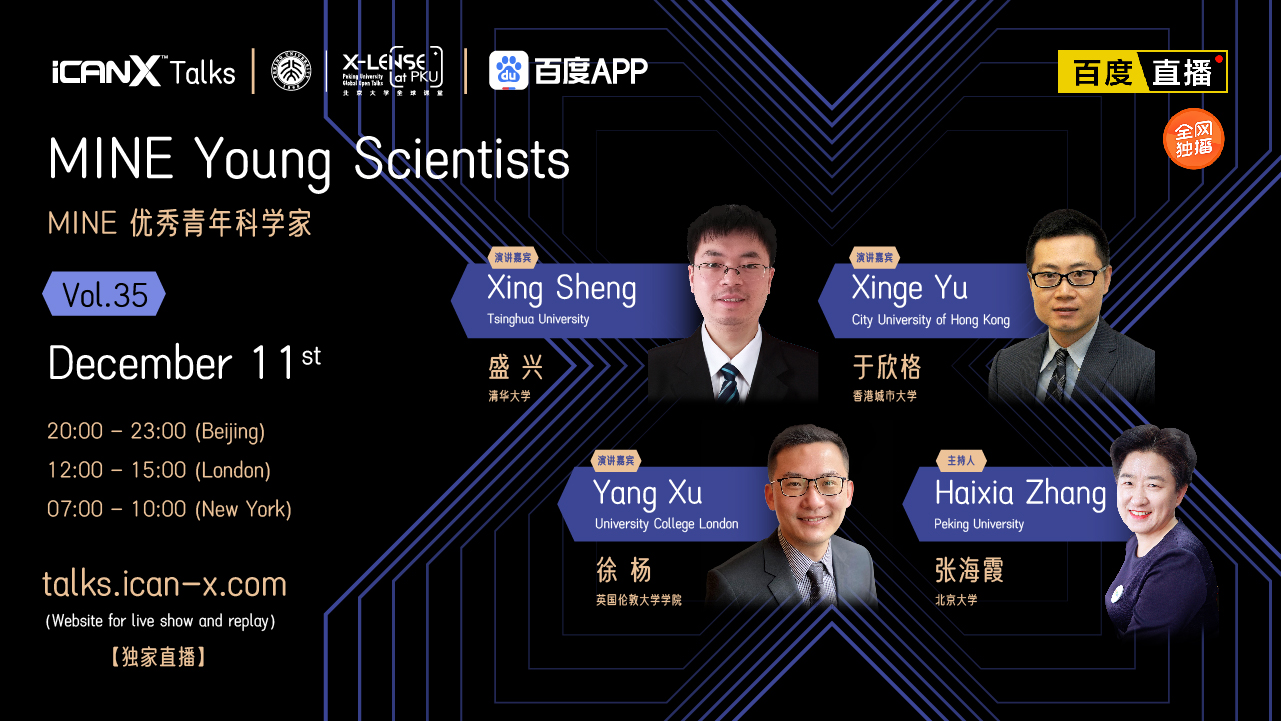博文
12月11日晚八点iCANX Talks 直播︱MINE 优秀青年科学家
||
北京时间12月11日晚8点,大家期待已久的 iCANX Talks第三十五期即将重磅来袭,本次邀请了获得MINE青年科学家奖的三位顶尖学者为大家带来最新科研成果。他们分别是来自香港城市大学的于欣格教授和来自清华大学的盛兴教授,以及来自英国伦敦大学学院的徐杨教授。盛兴教授将介绍面向新型神经接口的植入式微纳光电器件的最新研究进展,于欣格教授将带来皮肤集成传感器和触觉反馈界面在VR/AR中的应用的精彩报告,徐杨教授将介绍新兴能源存储技术中的的纳米离子学的最新进展。
The highly expected iCANX Talks Vol.35 will be ceremoniously holed at 8:00 pm of December 11(Beijing time). This time, three MINE Young Scientist Awardees are invited to bring you their latest scientific research reports. They are professor Xing Sheng from Tsinghua University, professor Xinge Yu from City University of Hong Kong and professor Yang Xu from University College London, UK. Professor Xing Sheng will present the latest progress in Implantable Optoelectronic Devices for Advanced Neural Interfaces. Professor Xinge Yu will talk about Skin-Integrated Sensors and Haptic Interfaces for VR and AR. And, Professor Yang Xu will present the latest progress in Nanoionics in emerging energy storage technologies.

Talk 1
Implantable Optoelectronic Devices for Deep-Brain Neural Modulation and Sensing
面向新型神经接口的植入式微纳光电器件
Xing Sheng 盛兴
Tsinghua University 清华大学
【Abstract】Bio-integrated high performance inorganic optoelectronic devices will provide new insights on interactions between light and bio-systems. Here we present unconventional strategies to design and fabricate thin-film, microscale optoelectronic devices and use them in implantable systems for deep brain neural signal modulation and sensing. Specifically, microscale LEDs are utilized to work as light sources to interact with genetically encoded neural actuators, stimulating neural activities, while photodetectors are used to monitor the fluorescence signals of light sensitive proteins, probing neural signals. Implanted devices are wirelessly powered and controlled by a miniaturized circuit system. These devices are implanted deeply into the mouse brain, demonstrating close loop monitoring and manipulation of neural activity in vivo. Such an integrated, deeply implanted and microscale optoelectronic system provides new insights on interactions between optical signals and neural systems.
【摘要】微电子和光电子等信息器件与生物系统,特别是神经系统的集成逐渐成为一个重要的发展方向。我们通过探索新型的微纳器件工艺,结合光学、电学、力学的设计,开发微纳尺度的光电子材料与器件,并与柔性异质衬底进行集成,探索其在可穿戴、植入式等生物医疗领域的应用。本报告中,我计划探讨运用新型的光电材料与器件的设计方法和工艺策略,实现植入式的光电芯片,用于生物神经信号的监测和控制,以及生物体内的无线能量传输。具体而言,我将介绍基于微纳半导体光电器件的新型植入式神经接口,用于多通道、多光谱、多模态的无线在体神经信号检测与调控。
在未来,我们计划继续探索新型器件工艺,结合电路设计、能量传输、信号处理等多领域知识,开发新型多功能的神经科学传感、诊断、治疗系统。
【Biography】Xing Sheng is currently an associate professor in the Department of Electronic Engineering at Tsinghua University, China. He obtained his PhD degree at Massachusetts Institute of Technology in 2012 (advisor: Lionel C. Kimerling), and his B.Eng degree at Tsinghua University in 2007. From 2012 to 2015, he was a postdoctoral researcher at University of Illinois at Urbana-Champaign (advisor: John A. Rogers). He has published more than 40 papers (including 5 invited papers) in peer-reviewed journals like Nature Materials, PNAS, Advanced Materials, etc. He is currently serving as an associate editor for OSA Optical Materials Express. He is selected into the “1000 Youth Talents Program” in 2015. His research interests are primarily in manipulating materials and photonic structures for micro- and nano-scale optoelectronic devices, to enable high performance and versatile functionalities. His recent efforts focus on light management in microscale devices (solar cells, LEDs, etc) for solar energy harvesting and biomedical applications.
【个人简介】盛兴,目前就职于清华大学电子工程系,担任副教授。他于2012年在美国麻省理工学院获得博士学位(导师:Lionel C. Kimerling),并于2007年在清华大学获得工学学士学位。2012年至2015年,他在美国伊利诺伊大学厄巴纳分校担任博士后研究员(导师:John A. Rogers)。他在Nature Materials, PNAS, Advanced Materials等期刊上发表了40多篇论文(包括5篇受邀论文)。他目前是OSA Optical Materials Express的编辑。他的主要研究兴趣是开发新型的光电子材料与器件,用于生物医疗技术。
Talk 2
Skin-Integrated Sensors and Haptic Interfaces for VR and AR
皮肤集成传感器和触觉反馈界面在VR/AR中的应用
Xinge Yu 于欣格
City University of Hong Kong 香港城市大学
【Abstract】Technologies for virtual and augmented reality (VR and AR) create human experiences through visual and auditory stimuli that replicate sensations associated with the physical world. The most widespread VR/AR systems use head-mounted displays, accelerometers and speakers as the basis for three-dimensional, computer-generated environments that can exist in isolation or as overlays with actual scenery. By comparison to the eyes and the ears, the skin is a relatively underexplored sensory interface for VR/AR technology that could, nevertheless, greatly enhance experiences, at a qualitative level, with direct relevance in areas ranging from communications and social media, to gaming, entertainment and prosthetics technology. Here we present materials, device structures, power delivery strategies and communication schemes as the basis for a wireless, battery-free platform of electronic systems and haptic interfaces capable of softly laminating onto the skin to communicate information via spatio-temporally programmable patterns of localized mechanical vibrations. The resulting technology, which we refer as epidermal VR, creates many opportunities where the skin provides an electronically programmable communication and sensory input channel to the body, as demonstrated through example applications in social media/personal engagement, prosthetic control/feedback and gaming/entertainment.
【摘要】虚拟现实(VR)和增强现实(AR)的技术是通过模拟外界的诸如声音和视觉刺激,并复制呈现给人体的感受器官实现虚拟的“真实”体验。目前广为人们熟知和认识的VR/AR是基于头戴式眼镜的3D立体成像技术加上一定的声音效果。除了视觉和听觉意外,针对人体皮肤的触觉感受的开发缺非常少。触觉在VR/AR中可以更为真实的提供虚拟现实的体验复制,从而可以用于诸如社交媒体、游戏装备、娱乐、和假肢的控制与传感等领域的诸多应用,因此有着非常重要的意义。报告将涉及新型基于无线控制、无电池驱动、皮肤集成的传感与触觉反馈界面的VR/AR技术。这种新型的VR/AR电子皮肤通过先进功能材料的选择,工程力学的设计、电子电路的优化、软硬件的协同与交互从而实现系统级别的集成,把此类技术扩展至4维甚至5维,实现触觉的反馈与控制。
【Biography】Dr Xinge Yu is currently an Assistant Professor of Biomedical Engineering at City University of Hong Kong (CityU). Xinge Yu got his bachelor degree form University of electronics Science and Technology of China (UESCT) in 2009 and conducted his Ph.D. research in printable flexible electronics at Northwestern University and received his Ph.D. degree in Optical Engineering from UESTC in 2015. From 2015 to 2018, Xinge Yu was a postdoctoral research associate at Northwestern University and University of Illinois at Urbana-Champaign, where he was working on flexible bio-electronics. Now Xinge Yu’s research group is focusing on skin-integrated electronics and systems for biomedical applications. He has published over 70 papers in the top journals, such as Nature, Nature Materials, Nature Biomedical Engineering, Nature Communications, PNAS, Science Advances etc., and held 15 patents pending or granted. Dr Yu serves as an associate director of the CAS-CityU Joint Lab on Robotics, and an associate editor of IEEE Open Journal of Nanotechnology. Dr Yu is also the recipient of New Innovator of IEEE NanoMed, MINE Young Scientist Award, TR 35 at 2020, etc.
【个人简介】于欣格,香港城市大学生物医学工程系助理教授、博导。2009年本科毕业于电子科技大学。2009-2015年,于美国西北大学与电子科技大学联合培养攻读博士,从事柔性金属氧化物的柔性化与大规模打印的研究,并于2015年获得博士学位。于2015-2018年先后在美国西北大学生物集成电子研究中心和伊利诺伊大学材料工程系担任博士后研究员,从事皮肤集成电子、生物电子以及多学科交叉的相关研究。目前研究方向为新型柔性电子材料与器件在生物医疗领域的应用。近年来,已在Nature, Nature Materials, Nature Biomedical Engineering, Science Advances, PNAS, Advanced Materials等学术期刊发表论文70余篇。担任香港城市大学-中科院机器人联合实验室副主任,IEEE新纳米技术杂志的副主编,获得IEEE纳米医学发明家奖,MINE青年科学家奖、TR35 of 2020等荣誉奖项。
Talk 3
Nanoionics in emerging energy storage technologies
新兴能源存储技术中的纳米离子学
Dr Yang Xu 徐杨
Department of Chemistry, University College London, UK 英国伦敦大学学院化学系
【Abstract】Na-ion and K-ion battery (NIB and KIB) are emerging energy storage technologies and have received rapidly increasing academic and industrial interest. This is driven by the increasing market of electric vehicles and large-scale stationary energy storage, as well as the promise of the NIB and KIB technologies to integrate renewable energy into the grid and provide electricity at rural areas for off-grid utilisation. The core challenge to develop the NIB and KIB technologies is to enhance the nanoionics of battery materials, because the large size of Na- and K-ion causes poor kinetics of ion transport and results in poor ion storage performance. This talk presents our work in material design at different length scales to take on the challenge of nanoionics. I will discuss the design in the short atomic arrangement via creating local atomic disorder and in the long atomic arrangement via regulation the level of amorphisation. The design significantly enhances the nanoionics of battery materials through creating ion transport pathways and facilitating ion accommodation and diffusion, which could provide insight into material designs for energy applications where nanoionics is of great importance.
【摘要】钠/钾离子电池由于其在资源与成本上的独特优势,已成为目前广受关注的新兴电化学能源存储技术,在电动汽车、大规模能源存储、可再生能源的电网集成、以及偏远地区的用电供应等领域展现了广阔的应用前景。然而钠/钾离子较大的离子半径严重限制了电极材料中的离子传输动力学,为相应离子电池的性能优化带来了巨大的挑战。因此,我们借助于纳米离子学的指导,对钠/钾离子传输机制与过程进行了深入探索,通过多尺度的设计,如局部无序度与长程无序度调控,筛选了一系列高性能电极材料,获得了高效稳定的钠/钾离子电池。相关的研究结果表明,纳米离子学的指导原则能有效缓解钠/钾离子大尺寸的负面影响,大幅提高钠/钾离子扩散系数,为高性能钠/钾离子电池材料的设计提供了适应性新思路。
【Biography】Dr Yang Xu is an Assistant Professor in the Department of Chemistry at University College London. His group is interested in designing and synthesising materials as well as understanding ion transport and storage at the nanometre scale for beyond-lithium energy storage technologies. The group is exploiting a wide range of materials with characteristic crystal structures and atomic arrangements (local defects, short- and long-range disorder) and investigating the correlations between the characteristics and the (electro)chemical processes occurring at electrode-electrolyte interface and in solid electrodes. Dr Xu has been actively working on energy storage materials and devices for over 10 years and is one of the pioneering scientists in the field of K-ion batteries. He is the recipient of the MINE Outstanding Young Scientist Award 2019 and the EPSRC (UK) New Investigator Award. In addition, he serves as a reviewer for internationally leading journals and was awarded an Outstanding Reviewer for Inorganic Chemistry Frontiers in 2016 and Best Reviewer for Science China Chemistry in 2019.
【个人简介】徐杨教授任职于英国伦敦大学学院化学系,长期从事钠/钾/高价离子电池电极材料设计与储能机制的研究工作。课题组致力于推动发展不同尺度下原子排列无序度优化策略,解析电化学离子存储过程中的物理过程和化学反应,理解电极材料的构效关系,在钾离子电池领域做出了特别积极的贡献。徐杨教授曾获MINE青年科学家奖,英国工程和物理科学研究委员会New Invesitgator Award,Inorganic Chemitry Frontiers和Science China Chemistry优秀审稿人等奖项。
每一期iCANX Talks直播结束后,都深受参会者好评,不仅为感兴趣的参会者和读者深度理解相关技术提供了帮助,也为研究生深入开展科研提供了一个很好的平台。更多精彩,尽在iCANX Talks,扫描二维码,关注更多精彩内容吧!

扫描上方二维码 关注更多精彩内容
收看直播请点击:talks.ican-x.com
https://blog.sciencenet.cn/blog-299-1261994.html
上一篇:张海霞┃基因遗传与精神传承
下一篇:IEEE 2022年总主席请愿候选人——赛义夫·拉赫曼(Saifur Rahman)教授